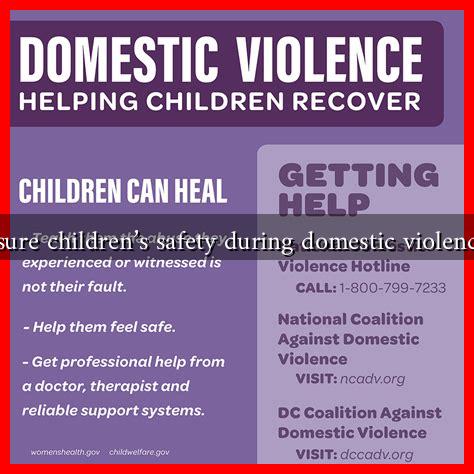-
Table of Contents
How to Ensure Children’s Safety During Domestic Violence Disputes
Domestic violence is a pervasive issue that affects millions of families worldwide. While the focus often lies on the adult victims, it is crucial to recognize that children are also deeply impacted by these situations. Ensuring their safety during domestic violence disputes is paramount. This article explores effective strategies to protect children, highlighting the importance of awareness, intervention, and support systems.
Understanding the Impact of Domestic Violence on Children
Children exposed to domestic violence can experience a range of emotional, psychological, and physical effects. According to the National Coalition Against Domestic Violence (NCADV), approximately 15.5 million children in the United States live in homes where domestic violence occurs. The consequences for these children can include:
- Emotional Distress: Children may experience anxiety, depression, and feelings of helplessness.
- Behavioral Issues: Exposure to violence can lead to aggressive behavior, withdrawal, or difficulties in school.
- Physical Health Problems: Stress and trauma can manifest in physical ailments, including headaches and stomachaches.
Understanding these impacts is the first step in ensuring children’s safety during domestic violence disputes.
Creating a Safety Plan
A safety plan is a personalized, practical plan that can help children and their caregivers prepare for potential domestic violence situations. Here are key components to consider:
- Identify Safe Spaces: Designate areas in the home where children can go to feel safe, such as a neighbor’s house or a trusted relative’s home.
- Establish Emergency Contacts: Create a list of trusted adults that children can call or go to in case of an emergency.
- Practice Escape Routes: Teach children how to exit the home quickly and safely if a situation escalates.
- Develop a Code Word: Establish a code word that children can use to signal that they need help without alerting the abuser.
Regularly reviewing and practicing the safety plan can empower children and help them feel more secure.
Seeking Professional Help
Involving professionals can significantly enhance the safety and well-being of children in domestic violence situations. Here are some resources to consider:
- Domestic Violence Hotlines: Organizations like the National Domestic Violence Hotline (1-800-799-7233) provide confidential support and resources.
- Counseling Services: Professional therapists can help children process their experiences and develop coping strategies.
- Legal Assistance: Seeking legal advice can help caregivers understand their rights and options for protecting their children.
Engaging with these resources can provide critical support for both children and their caregivers.
Educating Children About Healthy Relationships
Teaching children about healthy relationships is essential in preventing future cycles of violence. Here are some educational strategies:
- Open Communication: Encourage children to express their feelings and concerns about relationships.
- Role-Playing Scenarios: Use role-playing to help children recognize unhealthy behaviors and practice assertiveness.
- Promote Empathy: Teach children the importance of empathy and respect in all relationships.
By fostering an understanding of healthy relationships, children can develop the skills necessary to navigate their interactions positively.
Conclusion
Ensuring children’s safety during domestic violence disputes requires a multifaceted approach that includes creating safety plans, seeking professional help, and educating children about healthy relationships. By recognizing the profound impact of domestic violence on children and taking proactive steps, caregivers can help mitigate the risks and foster a safer environment. It is essential to remember that children are not just witnesses to domestic violence; they are victims in their own right. Protecting them is not only a moral obligation but a crucial step in breaking the cycle of violence for future generations.
For more information and resources, visit the National Coalition Against Domestic Violence.




